|
Winter, 2024
Many wildlife species have gone into hibernation or migrated south for the winter, but there are many wildlife species that are active year-round.
Read on, to learn about mudpuppies, get winter bird-feeding tips, and more. But first, here are some fun winter activity ideas to help you enjoy Minnesota’s winter wildlife.

Winter birding
Many bird species have migrated south for the winter, but there are still many great birding opportunities in Minnesota during the winter.
Woodpeckers, Black-capped chickadees and Northern cardinals are bird species that stay in Minnesota year-round. Others, like Snow buntings (scroll down for more info), Common redpolls and Dark-eyed juncos migrate to Minnesota and are only seen during the winter.
Look for these birds in your neighborhood and at your feeder. If you’d like to travel, visit your local state park or Scientific and Natural Area. They have birding checklists you can download to help you identify what you’re noticing.
A Black-capped chickadee, photo taken by the U.S Fish and Wildlife Service (USFWS)
|
Attend events
State parks and Scientific and Natural Areas have great events lined up all throughout winter. You can learn winter ecology, animal tracks or enjoy a stroll down a candlelight trail. Explore Minnesota also has a great calendar of wildlife events if you’re looking for more fun!
Go "owling"
Minnesota is home to many owl species. Going “owling” can be a fun activity with friends and family. Head out during the day to collect pellets or go outside at night to try to hear their calls. (Just make sure you bring flashlights and wear warm, reflective clothes if you go out at night. Do not shine flashlights at the owl unless you are utilizing a red filter, which protects their night vision.)
A Barred owl, photo taken by Rachel Lemmer
|
|
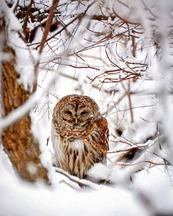 |
Cozy up with cams
If the temperature is too cold for your liking, get your birding fix from the comfort of your home with the DNR’s wildlife cameras.
The EagleCam and FalconCam, run by the Nongame Wildlife Program, feature up close views of these fascinating raptors. The EagleCam tours eagle habitat, with occasional looks at an eagle pair living in the area as well as a variety of other wildlife. The FalconCam is set up in downtown Saint Paul, offering an intimate look at peregrine falcons and their nest box.
Track tracks
Whether you’ve still got snow or are stuck with mud, this is a great time of year to look for animal tracks. Three Rivers Park District has a great guide to common animal tracks and the DNR has a track identification sheet you can print out and compare to the tracks.
Deer track in the snow, photo taken by USFWS
|
|
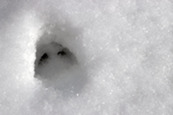 |
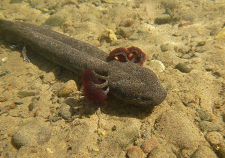
We humans may slow down and cozy up for the winter, but for the mudpuppy, this is the time to get moving!
The Mudpuppy salamander (pictured) uses its red fluffy gills to extract oxygen from the water, allowing it to spend its entire life underwater. Cold water holds more oxygen than warm water, so when the temperature drops in late fall and the lakes freeze over, they get more energy for swimming and eating crayfish and other aquatic insects.
Since they’re so active in the winter, you might accidentally catch a mudpuppy while out ice fishing. If you do, please let us know. Mudpuppies are a species of special concern in Minnesota. Your observations will help us learn more about their population and where they’re located in the state. Send us a quick email with the date, location and a photo to mmcbs.e-report@state.mn.us. Be sure to gently release it back into the water, without excessive handling, after you quickly snap the photo to document it.
|
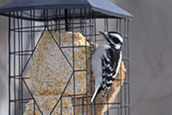
Not all birds migrate south for the winter. Some species, like Black-capped chickadees, American goldfinches, woodpeckers and Northern cardinals, stay in Minnesota year-round.
Attract them to your birdfeeder with large seeds, small seeds and suet. Also consider keeping your birdbath out or provide other sources of water for birds to drink.
Be sure to clean your feeders regularly. We recommend cleaning them once a week with a solution of water and 10% vinegar or bleach.
Visit our website for more winter bird feeding tips and consider posting what you notice at your feeders to eBird or Project FeederWatch.
Downy woodpecker, photo taken by USFWS
|
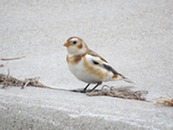
Snow buntings don’t mind a little cold.
In late fall, these songbirds migrate south from the Arctic to Minnesota to enjoy our “milder” winters and eat seeds and insects. They’ve adapted to thrive in winter environments, with more feathers and a lower body temperature that helps them fend off hypothermia.
They’re only seen in Minnesota during the winter, so enjoy them while they’re here! They can be found throughout much of the state. Look for them in open areas like fields and grasslands and along roadsides and lakeshores.
Snow bunting, photo taken by USFWS
|
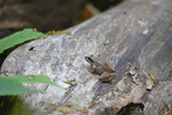
Frog and Toad Calling Survey
Last year, our Nongame Wildlife Program’s community science program ran a pilot relaunch of the popular Frog and Toad Calling Survey with experienced volunteers from the original survey. We had over 100 volunteers and assistants survey more than 70 routes across the state. A huge thank you to everyone who volunteered! We look forward to opening the survey up to new volunteers in the future.
All 14 of our target frog and toad species were detected across the state. Wood frogs had a strong showing, with a wide distribution and unusually prolonged calling period in many areas. As an added bonus, surveyors in southeastern Minnesota heard the state endangered Blanchard’s cricket frog for the first time on their route, and even got a recording. Data processing and analysis is still in progress, so stay tuned for more updates soon.
We are still improving and expanding this project and we deeply appreciate everyone’s help and time. We are a small team and have been building our science and outreach capacity, so thank you for your patience. Please look for more news soon!
Wood frog, photo taken by USFWS
|

Upcoming Projects
In 2024, we will continue to operate the Frog and Toad Calling Survey with existing and former volunteers.
We will be continuing our Chimney Swift Roost Monitoring (fondly called “Swift Sits”) this upcoming spring and fall. The exact time and date of the swift sits vary, so be sure to follow us on Facebook to stay up to date on those events.
We are also developing a Minnesota Bat Survey project with the Minnesota Biological Survey and the Midwest Bat Hub. Bat species are on the decline, so we’re excited to offer ways you can help Minnesota’s bats and bat research. Look for more information in our spring and summer Let’s Get Wild! issues.
Hibernating Big brown bat, photo taken by Melissa Boman
|
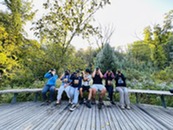
Bird by Bird is a new program by the Nongame Wildlife Program that shares the joy of birdwatching with classrooms and communities. The program is still in its juvenile stage and is yet to fully fledge, but what a beginning it has been!
Our cohort of seven high school BOLD (Birding and Outdoor Leadership Development) leaders learned about bird identification, ecology, and conservation careers and participated in over 250 hours of hands-on field experience so they can lead birding events in their communities this spring.
Two hundred elementary students are also participating in the Bird by Bird program, with classroom activities focused on bird observations and adaptations. Each class has been provided with a set of binoculars and field guides to encourage and inspire students to observe birds and wildlife at their newly installed schoolyard bird feeding stations.
To those of you who have volunteered, partnered with, or supported the Bird by Bird program, thank you for making the world of birds a joyful and welcoming space for all to enjoy. We are grateful for each and every one of you and your support.
To learn more about the program, visit our website: mndnr.gov/eco/nongame/bird-by-bird.html
Funding for this program was provided by the Minnesota Environment and Natural Resources Trust Fund as recommended by the Legislative-Citizen Commission on Minnesota Resources (LCCMR) and the Nongame Wildlife Program.
BOLD leaders learning about birding.
|
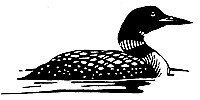
The Minnesota Nongame Wildlife Program!
When you donate to the Nongame Wildlife Fund on Minnesota state tax forms, you’re donating to the Nongame Wildlife Program. We use these donations to help fund wildlife research, restore Minnesota wildlife species, run the EagleCam and so much more.
Donations fund much of our work, so we can’t help Minnesota’s rare and vulnerable wildlife species without you. If you can, please consider donating a portion of your tax return to the nongame wildlife fund this year. Any amount helps and all donations are tripled, thanks to matching from the Reinvest in Minnesota critical habitat license plate.
You can learn more about donating and how we use your donations at mndnr.gov/donate
|
|